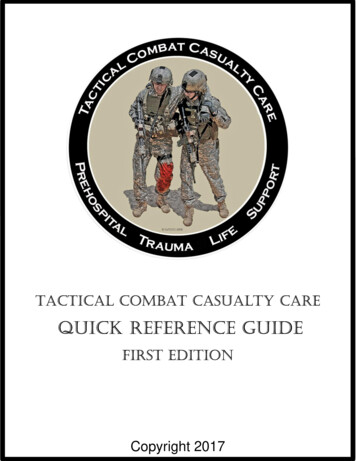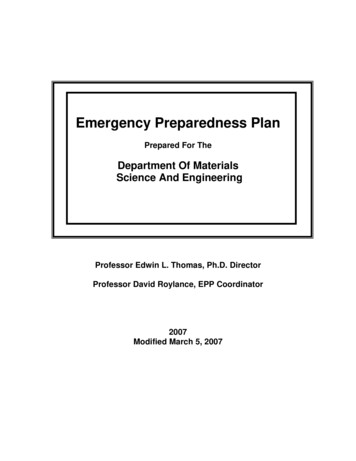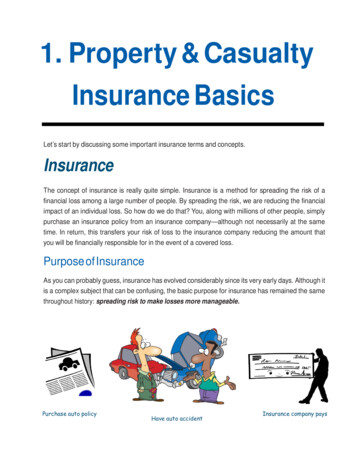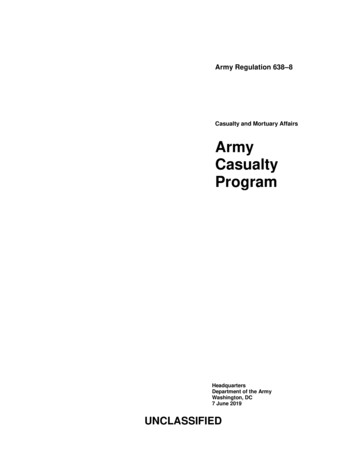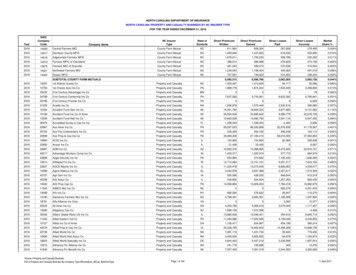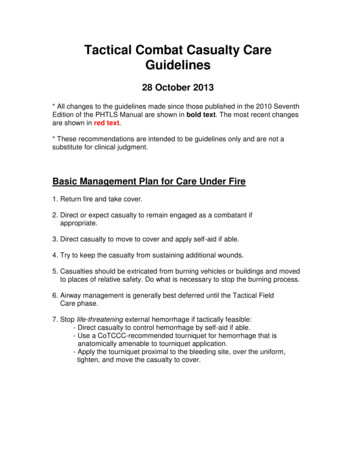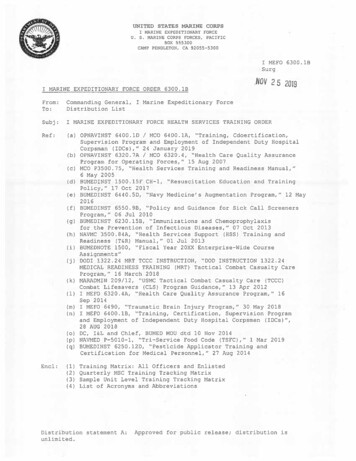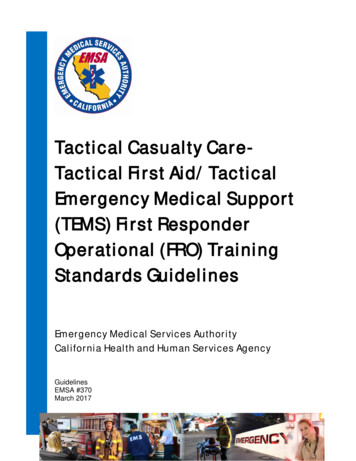
Transcription
UNITED STATES MARINE CORPSFIELD MEDICAL TRAINING BATTALIONCamp Lejeune, NC 28542-0042FMSO 109Coordinate Casualty/Tactical Evacuation (TACEVAC)TERMINAL LEARNING OBJECTIVE1. Given casualties in a tactical environment, evacuate patients to a higher level of care forfurther medical treatment. (FMSO-HSS-2003)ENABLING LEARNING OBJECTIVES1. Without the aid of reference, given a description or list of capabilities, identify the capabilitiesof the taxonomy of care, within 80% accuracy, per JP 4-02.1, Health Service Support. (FMSOHSS-2003a)2. Without the aid of reference, given a description or list, identify common litters used asTACEVAC platforms, within 80% accuracy, per Prehospital Trauma Life Support, CurrentMilitary Edition. (FMSO-HSS-2003b)3. Without the aid of reference, given a description or list, identify ground vehicles used asCASEVAC platforms, within 80% accuracy, per FM 8-10-6, Medical Evacuation in the Theaterof Operations. (FMSO-HSS-2003c)4. Without the aid of reference, given a description or list, identify aircraft used as CASEVACplatforms, within 80% accuracy, per FM 8-10-6, Medical Evacuation in the Theater ofOperations. (FMSO-HSS-2003d)5. Without the aid of reference, given a description or list, identify Casualty ReceivingTreatment Ships (CRTS) used as CASEVAC platforms, within 80% accuracy, per FM 8-10-6,Medical Evacuation in the Theater of Operations. (FMSO-HSS-2003e)6. Without the aid of reference, given a description or list, identify the casualty evacuationcategories, within 80% accuracy, per FM 8-10-6, Medical Evacuation in the Theater ofOperations. (8404-HSS-2004f)7. Without the aid of references, given a description or list, identify the purpose of the 9 Lineevacuation communication process, within 80% accuracy, per FM 8-10-6, Medical Evacuation inthe Theater of Operations. (FMSO-HSS-2003g)1-114
8. Without the aid of reference, given the necessary equipment, transmit a 9 Line Evacuationrequest, within 80% accuracy, per FM 8-10-6, Medical Evacuation in the Theater of Operations.(FMSO-HSS-2003h)9. Without the aid of reference, given multiple simulated casualties in a tactical environment,standard field medical equipment and supplied, and individual combat equipment, performcasualty evacuation, to prevent further injury or death, per FM 8-10-6, Medical Evacuation in theTheater of Operations. (FMSO-HSS-2003i)1-115
OVERVIEWTactical Evacuation Care (TACEVAC) is the third phase in the Tactical Combat Casualty Careprocess. Tactical evacuation encompasses both medical evacuation (MEDEVAC) and casualtyevacuation (CASEVAC). The care delivered in the TACEVAC phase can more closely resembleadvanced trauma life support guidelines than that in the first two phases. With either vehicularor air evacuation of wounded casualties from the battlefield, there is an opportunity for access toadditional medical equipment not available to the Corpsman during the first two phases. Oneexample is the use of pulse oximetry devices, which detect the percent of hemoglobin withoxygen bound to it and gives you an indication of how well the casualty is breathing. It alsoallows for early detection of pulmonary compromise or cardiovascular deterioration beforephysical signs are evident. They are highly reliable and can apply across all ages and races. Thislesson will describe the taxonomy of care, different methods of casualty evacuation, and how tocall for an evacuation.1. TAXONOMY OF CAREThe taxonomy of care outlines distinctive and overlapping care capabilities that enhanceperformance in a military force. The level of care commences at the scene of the injury andcontinues until the member receives definitive care and is discharged or returned to full duty.While this course teaches you the skills needed to operate using the first responder, forwardresuscitative, and en route care capabilities, there are five capabilities in the taxonomycontinuum of healthcare which are used when evacuating the wounded from the battlefield(see figure 1).Figure 1. Taxonomy of CareFirst Responder Capability - first aid and emergency care rendered at the point of initial injuryare the primary objectives of care at this level. Defined by its time requirements, first respondercare provides immediate medical care and stabilization to the patient in preparation forevacuation to the next capability in the continuum of care. Examples of First ResponderCapabilities include:- Self-aid/Buddy aid- Battalion Aid Station (BAS)1-116
Forward Resuscitative Capability - builds on the First Responder Capabilities. Characteristicsinclude performing advance emergency medical treatment as close to the point of injury aspossible, stabilizing the patient, and saving life and limb. Stabilization ensures the patient cantolerate evacuation. Examples of Forward Resuscitative Capabilities include:Medical Battalion - provides surgical care for the MEF. Provides stabilizing surgicalprocedures. Capable of holding patients up to 72 hours.Casualty Receiving & Treatment Ships (CRTS) - part of an Expeditionary Strike Group(ESG). They provide additional medical capabilities for receiving a mass casualty (up to 50casualties).Shock Trauma Platoon (STP) - small forward unit with one physician supporting the MEFspecializing in patient stabilization and evacuation. No surgical capability.Forward Resuscitation Surgical Suite (FRSS) - staffed with 8 to 10 personnel (two surgeons,one critical care nurse, one anesthesiologist, and four to six corpsmen). It consists of a twotent surgical system that provides a fully powered, climate-controlled environment withenough space for one operating room and one pre- and post-operative care room. The shelteris equipped with cutting-edge surgical gear and takes less than one hour to set up or breakdown.Theater Hospitalization Capability - services are delivered via modular hospital configurationsand/or hospital ships required to sustain forces in theater. These capabilities deploy as modulesor multiple individual capabilities that provide increasing medical services in a more robusttheater. The care offered either returns the patient to duty or stabilizes the patient to ensure theycan tolerate evacuation to a definitive care facility. Services encompass primary inpatient andoutpatient care, emergent care, and enhanced medical, surgical, and ancillary capabilities,including:Fleet hospitals - deployable ground asset that is located away from enemy threatproviding up to 500 hospital beds, 80 ICU beds, and 6 OR’s.Hospital ships (USNS Mercy and USNS Comfort) - deployable medical assetsproviding up to 1,000 beds, 100 ICU beds, and 12 OR’s.Definitive Capability - rendered to conclusively manage a patient’s condition and is usuallydelivered from, or at, facilities in the homeland, but may be delivered in facilities outside thehomeland. This capability generally leads to rehabilitation, return to duty, or discharge from thearmed forces. Because this care is usually given outside the operational area, the most advancedhealth care can be made available and accessible to the patient. It includes:CONUS Military, Veteran’s and selected civilian hospitals - provide fullconvalescent, restorative, and rehabilitative care to all patients returned to theContinental United States (CONUS).Overseas Medical Treatment Facilities - offers the surgical capability found in thetheater hospitalization capability, along with further definitive therapy for thosepatients in the recovery phase who can be returned to duty within the theaterevacuation policy. A patient who cannot be returned to duty will be evacuatedthrough the en route care capability.1-117
En Route Care Capability - en route care is the continuation of care during evacuation withinthe continuum without clinically compromising the patient’s condition. This capability can takeone of three forms – medical evacuation (MEDEVAC) in which dedicated special medical noncombatant platforms are used. The Air Force is the primary provider of MEDEVAC assets.Casualty evacuation (CASEVAC) are primarily non-medical evacuation platforms, however,some may have medical attendants such as a Hospital Corpsman or an Army Medic. The thirdcapability is Aeromedical evacuation. This type of evacuation is generally beyond the scope ofTCCC but it is typically used when transferring patients between medical treatment facilities.This course deals specifically with CASEVAC, which involves the unregulated movement ofcasualties aboard ships, land vehicle, or aircraft.2. METHODS OF EVACUATIONThe level of urgency and the tactical situation dictates the method of evacuation. Dependingupon which level of care you are in, Care Under Fire, Tactical Field Care, or Tactical EvacuationCare, will dictate how the casualty is transported. The most common forms of evacuation are:ambulatory, manual carries, litter evacuation, ground evacuation, air evacuation, or seaevacuation. Regardless, the casualty should be made as comfortable as possible and kept warmand dry. If an improvised litter is used, it should be padded and field-expedient material replacedwith conventional splints, tourniquets, and dressings as soon as feasible. A patient with minimalinjuries should be encouraged to stay in the fight if possible and to ambulate to an area wherecare can be safely provided.Manual CarriesFireman’s Carry - Used for unconscious and conscious patients. (See figure 2)1. Secure your arms around the patient's waist with their body lightly tiltedbackward to prevent their knees from buckling. Place your right foot betweentheir feet and spread them six to eight inches apart.2. With your left hand, grasp their right wrist and raise it over your head.3. Bend at the waist and knees, pull the patient’s arm over and down your leftshoulder, bring their body across your shoulders. Pass your right arm betweentheir legs.4. Place the patient’s right wrist in your right hand and your left hand on your leftknee for support in rising.5. Rise with the patient correctly positioned with your left hand free.Figure 2. Fireman’s Carry1-118
One-man Supporting Carry - Conscious patients only. The patient is able to walk using you as acrutch. (See figure 3)1. Raise the patient from the ground as in the Fireman’s Carry.2. With your left or right hand, grasp the patient’s left or right wrist and draw itaround your neck.3. Place your left or right arm around their waste.Figure 3. One-man Supporting CarrySaddle-back Carry - Conscious patients only. (See figure 4)1. Raise the patient to an upright position.2. Support patient by waist and move to the front of the patient.3. Have patient encircle arms around your neck.4. Stoop, raise patient to your back and clasp hands beneath his thighs.Figure 4. Saddl-back Carry1-119
Pack-strap Carry – Good for unconscious patients, however do not use if patient has fractures.(See figure 5)1. Raise the patient from ground as in Fireman’s Carry.2. Support by wrist and move to front of patient.3. Grasp patient’s wrist and hoist onto your back until their armpits are over yourshoulders.Figure 5. Pack-strap CarryTwo-man Supporting Carry – Patient is conscious and has no suspected fractures. (See figure 6)1. Same as One-man Carry, but done with two individuals.Figure 6. Two-man Supporting Carry1-120
Two-man Carry – Used for placing patient on a litter or moving short distances. Similar toperforming a patient log roll. (See figure 7)1. Two corpsmen kneel at one side of patient.2. One places one arm beneath the hips and the other beneath the knees.3. The second bearer places one arm beneath the shoulder and one beneath theback.4. Lift patient to knees, then stand up and carry at chest level to lessen fatigue.Figure 7. Two-man Carry1-121
Fore-aft Carry – Used to carry an unconscious patient for short distances. (See figure 8)1. With patient lying on their back, front bearer spreads legs of patient and stepsbetween legs with back towards patient, grasps legs behind the knees.2. Rear bearer kneels at the head of the patient, places arms under the armpitsand clasps hands on their chest.3. Bearers rise together.Figure 8. Fore-aft CarryFour Hand Carry – Patient must be conscious. (See figure 9)1.Each bearer grasps their left wrist with the right hand and then each other’sright wrist with the left hand.2. Patient sits on the interlocked hands supporting themself by putting one armaround each of the bearer’s necks.Figure 9. Four Hand Carry1-122
Two Handed Seat Carry – Used for conscious patients with no fractures. (See figure 10)1. With patient on their back, bearers on each side of the patient’s hips.2. Bearers interlock their wrists behind the patient’s thighs and back.3. Bearers rise together lifting patient.Figure 10. Two Handed Seat CarryClothes Drag Carry – Used during “under fire” conditions. (See figure 11)1. Grasp the patient’s shirt collar or gear and drag to safety.Figure 11. Clothes Drag CarryTypes of litters - there are six commonly used litters within the FMF.Talon Litter (See figure 12) - the Talon collapsible handle litterwas developed to meet the US Army’s urgent requirement toprovide casualty evacuation. The Talon litter allows a casualtyto be transported in one vehicle then transitioned to a standardevacuation platform without the need to transfer a casualty fromone litter to another. This is the most commonly used litter.1-123Figure 12. Talon Litter
Standard Army Litter (See figure 13) - the standard collapsible litter folds along thelong axis.Stokes Litter (See figure 14) - affords maximum security for the patient when thelitter is tilted.Figure 14. Stokes LitterFigure 13. Standard Army LitterPole-less Non-rigid Litter (See figure 15) this litter can be folded and carried by theField Medical Service Technician. It hasfolds into which improvised poles can beinserted for evacuation over longdistances.Figure 15. Pole-less Non-rigid LitterMiller (full body) Board (See figure 16) - the MillerBoard is constructed of an outer plastic shell withan injected foam core. It is impervious to chemicalsand the elements and can be used in virtually everyconfined-space rescue and vertical extrication. Itfits in stokes stretcher and will float a 250-poundperson.Figure 16. Miller (full body) Board1-124
Improvised Litters (See figure 17) - used for moving a casualty when a standard litteris not available, the distance may be too great for manual carries, or the casualty mayhave an injury that would be aggravated by manual transportation. These litters are tobe used in emergency situations only and must be replaced by standard litters at thefirst opportunity.Blouse / Flak Jacket LitterRolled Blanket LitterFigure 17. Improvised LittersProcedures for Carrying Litters1. When moving a patient, the litter bearers must make every movement deliberatelyand as gently as possible. The command “steady” should be used to prevent unduehaste.2. The rear bearers should watch the movements of the front bearers and time theirmovements accordingly to ensure a smooth and steady action.3. The litter must be kept as level as possible at all times, particularly when crossingobstacles such as ditches.4. Normally, the patient should be carried on the litter feet first, except when goinguphill or up stairs5. When the patient is loaded on a litter, his individual equipment is carried by two ofthe bearers or placed on the litter. When available, use Marines as your litterbearers.3. GROUND EVACUATION PLATFORMS(See figure 26)M997 Ambulance (See figure 18)- HMMWVframe with armor protection for crew andpatients. It is capable of transporting up to 4litter or 8 ambulatory patients.Figure 18. M997 Ambulance1-125
M1035 Ambulance (See figure 19) - HMMWVframe with removable soft-top. It is capable oftransporting 2 litter and 3 ambulatory patients.Figure 19. M1035 AmbulanceMK 23 7 Ton(See figure 20) - non-medical vehiclethat may be utilized for casualty transportationwhen available. It is capable of transporting 10litter or 20 ambulatory patients.Figure 20. MK 23 7 Ton Truck4. AIR EVACUATION PLATFORMS (See figure 26)CH-46 Sea Knight (See figure 21)- Dual rotor medium lift helicopter used totransport personnel and cargo (beingphased out by the MV-22 Osprey TiltRotor Aircraft).- When configured for litter racks, able tocarry 15 litters or 22 ambulatorypatients.Figure 21. CH-46 Sea KnightUH-1 Huey (See figure 22)- Light transport helicopter used totransport personnel and cargo.- When configured for litter racks, able tocarry 6 litters or up to 10 ambulatorypatients.1-126Figure 22. UH-1 Huey
MV-22 Osprey(See figure 23)- Tilt-rotor aircraft that takes off and landsvertically but flies like a plane. Thisaircraft is designed to eventually replacethe CH-46.- When configured for litter racks, able tocarry 12 litters or 24 ambulatory casualties.Figure 23. MV-22 OspreyCH-47 Chinook (See figure 24)- Dual rotor medium lift helicopter used totransport personnel and cargo for the US Army.- When configured for litter racks can carry 24litter patients or 31 ambulatory patients.Figure 24. CH-47 ChinookUH-60 Blackhawk (See figure 25)- Single rotor helicopter with multiple uses by notonly the Army but the Navy as well.- Can carry up to 6 litter patients if littermodification kit is installed.- Can carry up to 7 ambulatory patients if littermodification kit is not installed.- Patients can be loaded from either side.Figure 25. UH-60 BlackhawkNOTE: The Marine Corps does not have dedicated CASEVAC aircraft. Any of its aircraft canbe utilized as a “lift of opportunity” upon completion of its primary mission. The use ofhelicopter evacuation provides a major advantage because they greatly decrease the timebetween initial care and definitive treatment thereby increasing the casualty’s chances ofsurvival. Figure 17 below reflects USMC assets as well as those available through the Army andAir Force.1-127
AIRCRAFTSERVICE LITTER AMBULATORY ATTENDANTSTYPEUH-60 BlackhawkCH-47 ChinookUH-1 HueyCH-46 Sea KnightCH-53 Super SeaStallionMV-22 OspreyM997 HMMWVM1035 HMMWVMK 23(7-Ton Truck)62461573110221 Medic2 Medics1 Corpsman2 CorpsmenUSMC24372 CorpsmenUSMC12242 CorpsmenMEDICAL GROUND VEHICLESSERVICE LITTER AMBULATORY SMC/USAF48231 Corpsman1 CorpsmanVEHICLES OF OPPORTUNITY (GROUND)SERVICE LITTER AMBULATORY ATTENDANTSUSMC1020NoneFigure 26. Ground/Air CASEVAC Platform Data Description5. CASUALTY RECEIVING TREATMENT SHIPSSpecific ships within an Amphibious Task Force are designated as Casualty ReceivingTreatment Ships (CRTS).LHD/LHA - Amphibious Assault Ships with medical capabilities (See figure 27).Mission- Assault via helo, landing craft,and amphibious vehicle.- Primary amphibious landingships for MEF’s, MEB’s, andMEU’s.- Primary CRTSTransport capabilities- Flight deck with large internalhangar deck and well deck.- May receive casualties viahelicopter or waterborne craft.Figure 27. LHA Tarawa Class1-128
Medical CapabilitiesLargest medical capability of amphibious ships. When fully staffed,capabilities include:- 4 Operating Rooms- 15 ICU Beds- 45 Ward BedsHospital Ships (T-AH) (see figure 28)- the COMFORT and the MERCY are operated by theMilitary Sealift Command and are designed to provide emergency, onsite care for UScombatant forces deployed in war and other operations. The T-AHs provide a mobile,flexible, rapidly responsive afloat medical capability to acute medical and surgical care insupport of ATF; Marine Corps, Army, and Air Force elements; forward-deployed Navyelements of the fleet; and fleet activities located in areas where hostilities may be imminent.The T-AHs also provide a full-service hospital asset for use by other government agenciesinvolved in the support of disaster relief and humanitarian operations worldwide.Transport Capabilities- Flight deck capable ofreceiving rotary wingaircraft.Medical Capabilities- Operating Rooms (12)- ICU Beds (100)- Intermediate CareBeds (400)- Ward Beds (500)- Ancillary capabilitiesof lab, x-ray,pharmacy, computerized tomographyscanner, and blood storage.Figure 28. Hospital Ship6. CASEVAC CATEGORIES (See figures 29-31)Once a patient has been triaged and stabilized at the BAS, should that patient require furtheror additional medical treatment, he/she will be categorized for evacuation from the BAS tothe next higher capability of care. While evacuating patients, ensure that they are kept warmto prevent hypothermia! The category levels are as follows:Urgent Evacuation- Evacuation to next higher capability of medical care is needed to save life or limb.- Evacuation must occur within two hours.1-129
Urgent Surgical Evacuation- Same criteria as Urgent. The difference is that these patients need to be taken to afacility with surgical capabilities.Priority Evacuation- Evacuation to next higher capability of medical care is needed or the patient willdeteriorate into the URGENT category.- Evacuation must occur within four hours.Routine Evacuation- Evacuation to the next higher capability of medical care is needed to complete fulltreatment.- Evacuation may occur within 24 hours.Convenience- Used for administrative patient movement.URGENT/URGENT SURGICAL - 2 Hours or LessLife threatening injuries such as temporarily corrected hemorrhage, temporarily controlledairway injuries, or temporarily controlled breathing issues.Examples include (but not limited to) patients with:TourniquetsNeedle DecompressionCricothyroidotomyMajor Internal Bleeding(Figure 29)PRIORITY - 4 Hours or lessPotentially life threatening injuries such as compensated shock, fractures causing circulatorycompromise, and uncomplicated but major burns.Examples include (but not limited to) patients with:Compensated ShockBroken arm with loss of distal pulse2nd degree burns to a large portion of the abdomen or extremities(Figure 30)ROUTINE - 24 Hours or lessInjuries so insignificant or extreme that chances of survival are not based on evacuationtime.Examples include (but not limited to) patients with:AbrasionsCardiac ArrestMassive Head TraumaSmall FracturesFrostbite2nd /3rd degree burns 70% BSA(Figure 32)7. NINE LINE CASEVAC (See figure 33)A nine-line evacuation request is a standard format used by the Armed Forces forcoordinating the evacuation of casualties. Evacuation request transmissions should be by themost direct communication means available to the medical unit controlling evacuation assets.The means and frequencies used will depend on the organization, availability, and location inthe area of operations as well as the distance between units.The information must be clear, concise, and easily transmitted. This is done by use of theauthorized brevity code. The authorized brevity code is a series of phonetic letters, numbers,and basic descriptive terminology used to transmit casualty information. These codes1-130
indicate the standard information required for an evacuation commonly known as the “9Line”. This message is verbally transmitted in numerical “line” sequence utilizing thefollowing brevity codes:Line 1 - Location - location of the Landing Zone (LZ) where the casualties are to be pickedup. This information will be transmitted in the form of an eight digit grid coordinate.Line 2 - Radio Frequency, Call Sign - radio frequency and call sign that will be used by theground unit at the LZ. You should know this information before every operation.Line 3 - Precedence (Urgent, Urgent Surgical, Priority, and Routine) - number of casualtiesby precedence. Use the following codes:Alpha - UrgentBravo - Urgent SurgicalCharlie - PriorityDelta - RoutineEcho - ConvenienceLine 4 - Special Equipment - identifies any special equipment that will be needed, such as ahoist in the case where a helo cannot land. Use the following codes:Alpha - noneBravo - hoistCharlie - extraction equipmentDelta - ventilatorLine 5 - Number of Patients by Type - number of patients who are ambulatory and thenumber of litter patients. This determines whether or not the helo should be configured tocarry litters. Use the following codes:Lima - litter patientsAlpha - ambulatory patientsLine 6 - Security of Pickup Site - whether or not the enemy is near the LZ. If all of yourcasualties are routine and the LZ is not secured, then you may not get your requestedCASEVAC approved. Use the following codes:November - no enemy troops in areaPapa - possible enemy troops (approach with caution)Echo - enemy troops in area (approach with caution)X-Ray - enemy troops in area (armed escort required)Line 7 - Method of Marking Pickup Site - methods that you will use to mark your LZ andthen ask the pilot to identify. Use the following codes:Alpha - panelsBravo - pyrotechnic signalCharlie - smoke signalDelta - noneEcho - other1-131
Line 8 - Patient’s Nationality and Status - patients’ nationality and status. Use the followingcodes:Alpha - US militaryBravo - US civilianCharlie - non US militaryDelta - non US civilianEcho - enemy prisoner of warLine 9 - NBC Contamination - whether the LZ has been contaminated with NBC agents. Usethe following codes:November - nuclearBravo - biologicalCharlie - chemicalExample: During a routine patrol your platoon takes two casualties. One receives a gunshot wound to hisright arm. The other receives a gunshot wound to his abdomen and has signs and symptoms of shockassociated with internal hemorrhage. While you perform initial treatment, members of your platoon determinethat the closest potential landing zone for a helicopter is 300 feet to the West. Its grid location on the map isDH 1234 5678. Your call sign is Blue Thunder and your unit is operating on the frequency 99.65. Your unitcommander informs you that the site is secure and will be marked with green smoke. The following would beyour nine line radio CASEVAC Request transmission:Line 1: DH 12345678Line 2: 99.65 Blue ThunderLine 3: 1 Bravo, 1 CharlieLine 4: AlphaLine 5: 1 Lima, 1 AlphaLine 6: NovemberLine 7: CharlieLine 8: 2 AlphaLine 9: NoneFigure 33. Nine-Line Casualty Evacuation Request ExampleREFERENCES:Prehospital Trauma Life Support, current editionMedical Evacuation In A Theatre of Operations, FM 8-10-6, Chapters 5, 7-11Health Service Support, JP 4-02, Chapter I1-132
CASEVAC/TACEVAC Review1. Identify three different facilities that fall under the Forward Resuscitative Capability.2. How many litter patients can be carried in an M-997 vehicle.3. Describe the difference between the Urgent and Urgent Surgical categories.4. In relation to the Nine Line evacuation request, what are “authorized brevity codes”?1-133
physical signs are evident. They are highly reliable and can apply across all ages and races. This lesson will describe the taxonomy of care, different methods of casualty evacuation, and how to call for an evacuation. 1. TAXONOMY OF CARE The taxonomy of care outlines distinctive and overlapping care capabilities that enhance
